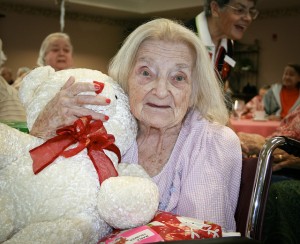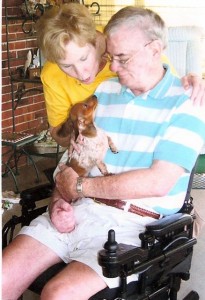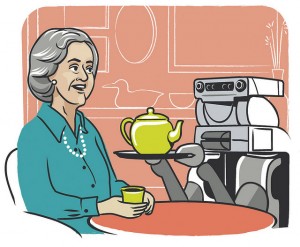The other day, I was leaving work and fell into step with a colleague who toils in the VOA newsroom. I hadn’t seen her for awhile, and I remarked, not very sensitively as I look back on it, that she looked awfully tired. It was the job, I figured.
Yes, to a degree, she said. But in the space of a city block walking beside her, I learned of her real burden: In addition to her fulltime job, she, and she alone, cares for her elderly father. When I say elderly, think older than 100. So there are many, many issues that she and a second companion — a scrappy little terrier — must handle. She was stoic about her situation, resigned to it, embracing of it in a brave sort of way, for as long as it lasts.

Old people can be endearing, but also a handful. And, if you're their only caregiver, there are few respites from those demands. (brutusfly, Flickr Creative Commons)
Millions of other people across the United States, too, must — or choose to — provide long-term care to their sick, elderly, or disabled relatives. Often these unpaid caregivers are middle-aged women who are raising children as well. It almost goes without saying that these burdens can strain marriages and drain life savings. And the effect on the caregivers can be devastating.
Some years ago on a trip to Georgia, I met such a person: Shirley Loflin, who herself was 66 years old. She told me she lived each difficult day — and every day for her was difficult — inspired by British Prime Minister Winston Churchill’s vow during the bleak early months of World War Two:
Never give in — never, never, never, never.
For the first 38 years of their marriage, life was slow and easy for Shirley Loflin and her husband, Geddie. But then, two states away in North Carolina, her mother’s health began to fail rapidly. After repeated trips to help her parents cook, can, and freeze meals, arrange live-in care, and deal with doctors, Shirley lost her mother, leaving her father alone and bewildered in the grip of early dementia.
So the Loflins brought Shirley’s dad home to live with them in Georgia.
Geddie Loflin ─ a traveling salesman who sold bedsprings and foam filling throughout the Southeast ─ helped watch after the old man whenever he could. And despite their new challenge, the couple held onto their dreams of a comfortable retirement filled with travel, golf, and relaxation.

Shirley, Geddie, and Lili — the Loflins' miniature dachshund, who became Geddie's constant companion. (Shirley Loflin)
But those dreams were dashed in an instant one cold December day just eight months after Shirley Loflin’s dad moved in. Geddie had a bad stroke. It took his speech and paralyzed him on the right side. In a flash, Shirley was the caregiver for both men.
And before long, each of them grew jealous of the attention that Shirley was paying the other. Her days and nights became an unrelenting procession of toil and tears. “I was fast burning out,” Shirley told me.
I had broken out in hives, and I had gained weight. I was doin’ everything ─ three meals a day and the house and the yard and the car, and I just never had a minute to myself. I had to give up all my hobbies and everything. After awhile, the mental stress on it was pretty bad.
After several years of this pressure, Shirley placed her father in an assisted-living home. Within a few months, he, too, suffered a stroke and died.

Unfortunately it's not robots but humans, with newly strained lives of their own, who care for our elderly. (willowgarage, Flickr Creative Commons)
But back in the family household, there was no let-up in the demands of Geddie’s care. Feeling alone, overwhelmed, and hopeless, Shirley Loflin watched her own health and spirits decline. “I just thought my life was over,” she remembers.
For years, friends had urged Shirley to reach out for help. Finally, she listened. She got some part-time help caring for Geddie and enrolled in a workshop at a caregiving institute founded by former U.S. First Lady Rosalyn Carter, who lived in nearby Americus, Georgia.
Encouraged and revived, Shirley Loflin took charge of the institute’s chat room on the Internet. She began fielding stories just like her own from all over the world.
“They just give up because everything has been taken away,” Shirley summed up a lot of the messages.
While friends of the Loflins enjoyed their retirement beach homes, golf games, exotic travel and simple strolls around South Georgia, Shirley and Geddie soldiered on. “We’re not meant to do that,” Shirley put it, simply. Instead the couple read, listened to baseball games, got outside for an occasional picnic. But once she got her Internet friends and a breather or two in her life, Shirley said she felt fulfilled.
“If I can help one caregiver feel better and do a good job, and not think life’s over, then I feel like I’ve done well,” she told me.
Men and women like Shirley Loflin around the world watch over their elderly and sick, often without complaint. But this age-old model of familial care is complicated these days by the increasing number of women, like my colleague, in the workplace. No longer is it always possible for her to be at home, available at all times to care for others.
Donna Wagner, a veteran gerontologist who is a dean at New Mexico State University’s College of Health and Social Sciences, believes that there’s a sudden boom of interest in family caregiving, fueled by the realization that America’s elderly population is swelled by baby boomers, born right after World War Two. Yet just as the population steadily ages ─ and insurance pressures cut short the time patients may spend in the hospital ─ care for the old and infirm is placed in the untrained hands of family members.
And Wagner says that as the pressures on families grow, few weary caregivers think to reach out for help: “Most people who are helping an older relative view it as just being a good daughter, or just being a good son.”
Already one in four American families cares for an elderly adult at home. State and federal programs pay some medical expenses. But programs such as Medicaid require that a patient be nearly destitute before help kicks in. Families must bear the costs of installing safety devices such as hand railings and ramps.
Carol Levine, who directs the Family and Health Care Project of the United Hospital Fund in New York, says that almost half of personal bankruptcies in the United States can be traced to the costs of medical care, including home-care demands that come crashing down upon a family. “The burden of daily medical care affects the dreams of children whose educational possibilities are limited, and of all of the people in the family who might have had other ideas about how to spend their later years,” she says. “It can truly create havoc within a family.”
Carol Levine herself became a caregiver after her husband became totally disabled after a near-fatal auto accident and required 24-hour care.

The perfect title. Think about what it means for those who take on this responsibility. (Vanderbilt University Press)
She edited a little book for caregivers, published by the United Hospital Fund, called Always on Call. She says she has profound respect for adults who face loneliness, stress, depression, and the withering of lifelong dreams as they attend to the needs of others.
There’s a lot of sadness. But there’s also some sense of doing the right thing and knowing you’ve done the best that you can without a lot of help.
In 2000, the U.S. Congress passed, and President Bill Clinton signed, the National Family Caregivers Act. It led to the distribution of $125 million among the states to fund counseling and support groups. And it provided some caregivers a hand at home ─ giving them a few precious hours away from the never-ending drumbeat of demands.
Shirley Loflin, who’s now 76, cared for Geddie for 11 years. Things got a little better when he moved to a motorized wheelchair that the couple called “the Batmobile,” enabling him to tool around the neighborhood on his own. It gave Shirley a smidge of time to herself.
After Geddie died following a heart attack in 2004, Shirley took flight, both personally and avocationally, if that’s a word, which I guess it isn’t. Friends treated her to a month in the South of France, and they took shorter trips as well. She got back to her knitting of prayer shawls for her church. And she joined the board of Rosalyn Carter’s Institute for Caregivers and was soon accepting invitations to speak about the burdens — and blessings — of these informal, home-based, unpaid nurses, storytellers, bedpan orderlies, short-order cooks, and lullaby singers all over the country.
Oh, and she’s dating a “gentleman,” as she calls him — a retired band director over in the coastal Georgia town of Brunswick.
I asked her for one best piece of advice for those who are caught in her former situation, and here it is:
Keep your friends, no matter what you’re going through. Don’t withdraw. Keep ’em when times are tough, keep ’em when you lose your loved one and are grieving, and they’ll be there when better times come.



